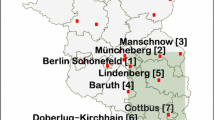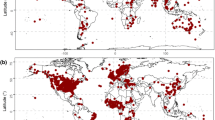Abstract
A functional time series approach is proposed for investigating spatial correlation in daily maximum temperature forecast errors for 111 cities spread across the U.S. The modelling of spatial correlation is most fruitful for longer forecast horizons, and becomes less relevant as the forecast horizon shrinks towards zero. For 6-day-ahead forecasts, the functional approach uncovers interpretable regional spatial effects, and captures the higher variance observed in inland cities versus coastal cities, as well as the higher variance observed in mountain and midwest states. The functional approach also naturally handles missing data through modelling a continuum, and can be implemented efficiently by exploiting the sparsity induced by a B-spline basis. The temporal dependence in the data is modeled through temporal dependence in functional basis coefficients. Independent first order autoregressions with generalized autoregressive conditional heteroskedasticity [AR(1)+GARCH(1,1)] and Student-t innovations work well to capture the persistence of basis coefficients over time and the seasonal heteroskedasticity reflecting higher variance in winter. Through exploiting autocorrelation in the basis coefficients, the functional time series approach also yields a method for improving weather forecasts and uncertainty quantification. The resulting method corrects for bias in the weather forecasts, while reducing the error variance.








Similar content being viewed by others
References
Aue A, Horváth L, Pellatt DF (2017) Functional generalized autoregressive conditional heteroskedasticity. J Time Ser Anal 38(1):3–21
de Boor C (2001) A practical guide to splines. Applied Mathematical Sciences, Springer, New York
Dokumentov A, Hyndman R, Tickle L (2018) Bivariate smoothing of mortality surfaces with cohort and period ridges. Stat 7(1):1–13. https://doi.org/10.1002/sta4.199
Gabrielsen A (2021) ARMAX-GARCH-K-SK toolbox (estimation, forecasting, simulation and Value-at-Risk applications). https://www.mathworks.com/matlabcentral/fileexchange/32882-armax-garch-k-sk-toolbox-estimation-forecasting-simulation-and-value-at-risk-applications, MATLAB Central File Exchange. Retrieved July 12, 2021
Hansen PC (1987) The truncated SVD as a method for regularization. BIT Numer Math 27(4):534–553. https://doi.org/10.1007/bf01937276
Hörmann S, Kokoszka P (2012) Functional time series. In: Time series analysis: methods and applications, handbook of statistics, vol 30, Elsevier, pp 157–186
Hunyadi L (2020) B-splines. https://www.mathworks.com/matlabcentral/fileexchange/27374-b-splines
Hyndman R, Booth H (2008) Stochastic population forecasts using functional data models for mortality, fertility and migration. Int J Forecast 24(3):323–342
Hyndman R, Shahid Ullah M (2007) Robust forecasting of mortality and fertility rates: a functional data approach. Comput Stat Data Anal 51(10):4942–4956
Hyndman R, Shang H (2009) Forecasting functional time series. J Korean Stat Soc 38(3):199–211. https://doi.org/10.1016/j.jkss.2009.06.002
Hyndman RJ, Booth H, Yasmeen F (2013) Coherent mortality forecasting: the product-ratio method with functional time series models. Demography 50(1):261–283
Jolliffe I (2002) Principal component analysis. Springer Series in Statistics. Springer, USA
Kowal DR, Matteson DS, Ruppert D (2017) A bayesian multivariate functional dynamic linear model. J Am Stat Assoc 112(518):733–744
Kowal DR, Matteson DS, Ruppert D (2019) Functional autoregression for sparsely sampled data. J Bus Econ Stat 37(1):97–109
Ramsay J, Silverman BW (2005) Functional data analysis. Springer Series in Statistics, Springer, USA
Shang HL, Booth H, Hyndman R (2011) Point and interval forecasts of mortality rates and life expectancy: a comparison of ten principal component methods. Demogr Res 25:173–214. https://doi.org/10.4054/DemRes.2011.25.5
Tsay RS (2010) Analysis of financial time series. John Wiley & Sons, UK
Acknowledgements
This work is supported in part by the Natural Sciences and Engineering Research Council of Canada (PGS-D 502888), the National Science Foundation (DMS-1455172), a Xerox PARC Faculty Research Award, the United States Agency for International Development (USAID), and Cornell University Atkinson Center for a Sustainable Future (AVF-2017).
Author information
Authors and Affiliations
Corresponding author
Additional information
Publisher's Note
Springer Nature remains neutral with regard to jurisdictional claims in published maps and institutional affiliations.
Rights and permissions
Springer Nature or its licensor (e.g. a society or other partner) holds exclusive rights to this article under a publishing agreement with the author(s) or other rightsholder(s); author self-archiving of the accepted manuscript version of this article is solely governed by the terms of such publishing agreement and applicable law.
About this article
Cite this article
Jang, P.A., Matteson, D.S. Spatial correlation in weather forecast accuracy: a functional time series approach. Comput Stat 38, 1215–1229 (2023). https://doi.org/10.1007/s00180-023-01338-4
Received:
Accepted:
Published:
Issue Date:
DOI: https://doi.org/10.1007/s00180-023-01338-4




